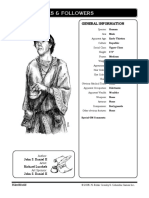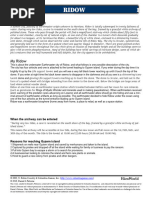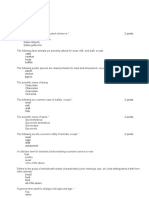ChyAlmanac2 1
ChyAlmanac2 1
Uploaded by
7ku3xrslCopyright:
Available Formats
ChyAlmanac2 1
ChyAlmanac2 1
Uploaded by
7ku3xrslOriginal Title
Copyright
Available Formats
Share this document
Did you find this document useful?
Is this content inappropriate?
Copyright:
Available Formats
ChyAlmanac2 1
ChyAlmanac2 1
Uploaded by
7ku3xrslCopyright:
Available Formats
F
A CHYBISAN ALMANAC 1
S
everal calendars are in use on Hârn. Most are have sufficient oxen to complete the plowing within 60
religious calendars used by churches and their days.
holy orders to mark the passage of time in The spring thaw signals the time the miners return to the
accordance with their own traditions and beliefs. Anadel Hills to re-open the mines, repair damage caused
The one calendar in common usage reckons dates from the by the harsh winter or marauding Bujoc, and drain them
founding of the Kingdom of Melderyn and is referred to as of water that accumulated over the winter. Timbercutters
"Tuzyn Reckoning." Under this system the year is divided and charcoalers set to work providing the fuel which will
into twelve months, the names of which have religious be used in the smelting and refining that follows.
origins. Each month is based on the cycle of Yael, Kethira's
As the strong winter winds subside, Chybisan
moon, which is almost exactly thirty days. Yael is full on
maritime trade resumes. Niviks carry trade to markets as
the fifteenth of each month and new (dark) on the thirtieth
far away as Aleath, while talbars and barges trade along
day of each month.
the river.
A TIME FOR ALL THINGS Early spring is the foaling season and their birthing
Unlike many of us, the people of Chybisa are heralds the Great Horse Fair that follows in the month of
constantly surrounded by reminders of the rhythm of Peonu.
nature. Even the kingdom's capital of Burzyn is hemmed
in by farmland, with the peasant's activity in the fields
Peonu
forming a backdrop to the scenery of the town-dweller's
Peoni's month begins with the Restoration Festival,
daily life. To Chybisans, the passage of time is not a
a Peonian celebration of spring's renewal of life after the
turning of the calendar's page. It is measured in the
dark and cold of winter. Last year's straw idol is taken
spring thaw, the turning of the soil, the sowing, and the
from the village shrine and ceremoniously burned in the
harvest, and punctuated with the passage of the great
newly sown field while a new one, made of the hay left
spring and fall caravans and the hustle and bustle of the
from last year's harvest, is installed in the shrine.
market fairs they bring. The vernal equinox falls on the
first day of Nuzyael, marking both the beginning of Sowing and harrowing of the spring crops is
spring and the beginning of the New Year. usually complete by early Peonu and children defend the
newlysown seed from crows and other marauding birds
SPRING with slings.
The first plowing of the fallow is usually complete
HARNIC TERRAN SUNRISE SUNSET by the end of the month.
MONTH DATES 1st / 16th 1st / 16th
With sowing of the fields complete, attention turns
Nuzyael March 21 05:53 18:08 to gardens. They grow not only such staples of the
April 20 05:28 18:32 peasant diet as cabbages but also cash crops such as flax
Peonu April 21 05:04 18:57 and hemp. Dyeplants like madder (red), woad (blue),
May 21 04:45 19:15 dyer's greenweed (green) and weld (yellow) are also
grown in gardens, for home use as well as for sale to
Kelen May 22 04:26 19:35 clothiers and at the market. Culinary and medicinal
June 20 04:18 19:42 herbs, such as parsley, fennel, celery, camomile, mint,
summer savoury, catmint, mustard, opium poppy and
Nuzyael
Winter crops (wheat and rye), planted last Halane, coriander, also find places in the garden.
already cover about half of the active field. Cows come back into full milk as pastures go green,
Sowing and harrowing of the spring crops (barley, an event which in some areas is believed to be associated
oats, peas, beans and vetches) on the remainder of the with the eclipse of Yael on the 14th day of Peonu. This is
active field begins with the new year. a holdover from religious practices common to the region
before the arrival of Peonian missionaries; today such
Meanwhile, plow teams begin the first plowing of beliefs are carefully discouraged by Peonian clerics.
the fallow fields while the soil is still soft enough to turn
easily. Each team consists of a heavy plow pulled by four The eclipse of Yael also marks the beginning of the
to eight oxen, guided by a plowman and an ox-goader. Great Horse Fair, the time when the Hodiri bring their
The team can do as much as one acre a day; most villages two-year old horses to market in Burzyn, trading them
A Chybisan Almanac 2.1 ©2015 Sophia Tribad & HârnWorld
N. Robin Crossby, Columbia Games, Inc. and Kelestia Productions, Ltd. Peoni's Tear
A CHYBISAN ALMANAC 2
for the products of civilization. The barbarians arrive Oedolynaech, or fourth baptism, and in some areas of the
when they arrive, but the fair always runs through the kingdom the haymaking is part of that rite of passage,
end of the month when it merges with the market fair marking one step in the transition to adulthood when a
that accompanies the arrival of the annual Genin's Trail youth is permitted to wield the scythe. Those not yet old
caravan. enough to mow follow behind, turning the hay to ensure
The Feast of Saint Fardir falls on 16 Peonu, with a it dries evenly.
tournament at Namadees sponsored by the Order of the In areas where three plowings of the fallow field
Spear of Shattered Sorrow and the Lady of Paladins. are the norm the second is generally begun after the
Tradition holds that Fardir's last battle was fought near haymaking. This plowing is a little deeper than the first to
the present-day abbey, and that the silver spearhead of expose the roots of weeds to the air and Nolomar's rays.
Protector, his enchanted spear, is hidden in the hills of As much manure as is available is spread on the field
Anadel across the river from Ulmstane. before the teams begin their work.
Merchants from Thay who form the Genin's Trail The end of the month brings the shearing of the
Caravan begin arriving in Burzyn as early as 24 Peonu. sheep, marking the end of spring.
There they become part of Burzyn's semi-annual market
fair as the great caravan grows in size and prepares to SUMMER
continue their journey to Tashal. The caravan brings the
raw materials of trade and the renowned Thay pottery, HARNIC TERRAN SUNRISE SUNSET
but Melderyni merchants arriving at Burzyn's dock to MONTH DATES 1st / 16th 1st / 16th
join them also carry luxuries from Lythia - olives, wine Nolus June 21 04:09 19:50
and spirits, spices, incense, sponges, exotic dyes, rare July 21 04:18 19:42
quicksilver, ivory, pearls, fine linens and sometimes silk
Larane July 22 04:26 19:33
and cotton. Chybisan merchants join the caravan as it
August 21 04:46 19:14
leaves Burzyn, taking Hodiri horses, Sindarin and
Chymak craftwork, and refined Chybisan metals from the Agrazhar August 22 05:06 18:54
mines of Anadel to the markets of Tashal. September 22 05:18 18:42
Kelen Nolus
Haymaking is the main event of Kelen, and in Chybisa it The second plowing of the fallow field is usually
is a communal activity of games and competitions. complete by the end of Nolus. In the active fields, the
Kelen is the traditional month for the Peonian loathsome task of weeding is the most important task.
For the peasantry, Nolus is the hungry month.
Grain stores are at their lowest ebb, awaiting
replenishment from the forthcoming harvest, and
peasants in need eke out their diet by foraging and
many no doubt by poaching. The Angyla Festival, held
on the 27th in most parts of Chybisa, gives some relief,
with a day of revelry highlighted by a grand feast that is
A Chybisan Almanac 2.1 ©2015 Sophia Tribad & HârnWorld
N. Robin Crossby, Columbia Games, Inc. and Kelestia Productions, Ltd. Peoni's Tear
F
A CHYBISAN ALMANAC 3
typically sponsored by the wealthier villagers. This is the AUTUMN
traditional occasion for the Peonian Frinaech, or third
baptism, marking the passage from infancy to childhood HARNIC TERRAN SUNRISE SUNSET
for those who will be old enough to participate in next MONTH DATES 1st / 16th 1st / 16th
month's harvest.
Azura September 23 05:54 18:06
October 22 06:05 17:55
Larane Halane October 23 06:41 17:18
The main grain harvest begins in Larane if the November 22 02:02 16:58
weather allows and usually is completed by the end of
the month. The winter crops (wheat and rye) ripen and Savor November 23 07:22 16:37
are harvested first, followed by the spring grains (barley December 21 07:30 16:30
and oats). A team of five people - four reapers and a
binder - can harvest two acres of crops a day. Azura
The harvest iis interrupted for at least two days to Peoni's faithful begin the month with fasting, prayer
celebrate the Laranian Feast of Saint and meditation in preparation for the Harvest
Ambrathas. Burzyn's Sabalyne Common Home Festival. Their fast is broken on the
resembles a camp of war as knights from all over fourth day with a lavish feast on the bounty of
Chybisa, accompanied by their retainers the fresh harvest. The Harvest Home
and men-at-arms, converge for the Festival bridges religious affiliations,
tournament hosted there on 17 and all present in the village
Larane by the Temple of Larani. take part in the festivities.
As this is also the traditional By Azura beechnuts and
date for the knighting of squires, the acorns are ripening and falling, and
tournament opens with the swineherds drive their charges
concluding rites of the Laranian into the woods to forage for
Tirannon ritual. More ambitious them, a process known as pannaging.
knights often choose instead to Whatever wild fruits and nuts are
make the journey to Olokand for available are also collected for
the Chelebin Tournament of human consumption. Wheat
Chivalry (12 - 22 Larane), Kaldor's most stubble, which was left standing in the
important tourney. fields, is gathered in to mix with hay as
winter fodder.
Agrazhar The third and final plowing of the
Winnowing and threshing are the main fallow field is done prior to next month's
works as the grain harvest is carefully prepared for sowing of the winter crops. Livestock are turned out onto
storage. Left unground, grain can last several years if kept the previously active fields to graze whatever stubble
dry and free from vermin. Flour has a much shorter shelf- remains.
life, and milling the grain is done as and when necessary.
Beans and peasecods are brought in from the fields and
Halane
carefully dried as a source of both food and animal
The celebrations of Azura are followed by the
fodder over winter.
accounting of Halane. Rents, debts and obligations are
Flax, hemp and other cash crops are harvested from summed and paid. Serfs who failed to meet their labor
the garden and carefully prepared to make them ready obligations are fined, with the debt usually paid in kind
for use in the indoor months of winter. The fruit harvest rather than coin. Manorial lords have their own
begins late in the month; some will be put into storage, obligations to pay and it is in Halane that tribute, aid and
while some goes into ciders in preparation for next scutage usually comes due.
month's Harvest Home Festival.
In urban areas, landlords begin collecting from their
tenants the property taxes that will fall due on the first of
Savor.
A Chybisan Almanac 2.1 ©2015 Sophia Tribad & HârnWorld
N. Robin Crossby, Columbia Games, Inc. and Kelestia Productions, Ltd. Peoni's Tear
A CHYBISAN ALMANAC 4
On the manor, the previously fallow field becomes mercenaries. With the mines closed, the miners' barge
the next year's active field with the sowing and traffic ceases and there is little other traffic on the river.
harrowing of the winter crops (wheat and rye). The cold and rain of winter largely confine peasants
Old stock and swine are slaughtered in Halane and indoors where they perform whatever tasks they can to
smoked or salted to provide a supply of meat, however while away the hours and perhaps earn a little cash:
meager, for the coming winter. hemp is wound into rope or cord; flax and wool are spun
Reeds and sedges are cut to be dried for thatching, into yarn; women weave and embroider; men carve or
and bracken is gathered to use as winter bedding for engage in other handicrafts.
cattle. Threshing and winnowing continue whenever the When the weather permits, villagers will assart
weather is too wet to do outside work. woods and maintain the fief's fences, bridges and ditches.
The Genin's Trail Caravan returns to Burzyn at the
end of the month, with their arrival marking the Navek
beginning of Burzyn's autumn market fair (23 - 25 The noble class entertains itself during the
Halane). Still called the Salt Fair, it is better known for dormancy of winter with formal courts and less formal
more exotic goods carried from the great fair at Tashal: fetes. More than an exercise in hospitality, these
perfume from Tharda; amber, fur and rich honey from occasions give the host an opportunity to display his
Orbaal; gems, jewelry, arms and armour from Azadmere; wealth, power, and prestige to his peers as well as his
brassware and fine cloth from Kanday; and vellum and vassals. The barons of Chybisa typically host these affairs
fine Vemionshire wool from Kaldor. during the month of Navek.
Savor For the peasant class, the monotony of the short
The month begins in urban areas with the payment days and long winter nights is broken only by the onset
of the annual property tax. Landlords are responsible for of calf birthing.
the tax, even if they have failed to collect it from their
The month ends on the Night of Shadows with, as
tenants.
superstitious folk believe, the night of Navek's new moon
In rural areas, preparations for the hardships of heralding the arrival on Kethira of demons and the
winter are well underway. The last of the meats are servants of evil gods for a thirteen-day reign of mischief
salted and smoked and what little threshing work and terror. In some rural areas of Chybisa, huge bonfires
remains is completed. light the night sky, intended to drive the demons away.
Talbars and barges continue their trade along the
river, but by the end of Savor most sea-going vessels
Morgat
have returned to their ports for the winter.
Morgat is the time for the pruning of orchards and,
where they grow, the vineyards.
WINTER
Late in the month, the end of winter is heralded by
HARNIC TERRAN SUNRISE SUNSET the onset of lamb and kid birthing, prompting peasants
MONTH DATES 1st / 16th 1st / 16th and craftsmen to repair tools in preparation for the
coming spring.
Ilvin 22 December 07:39 16:21
21 January 07:29 16:31 The year ends with the Royal Court, the occasion
when Chybisa's barons and other important and
Navek 22 January 07:20 16:41
influential people enjoy the hospitality of the crown.
21 February 06:58 17:02
Morgat 22 February 06:37 17:23
20 March 06:15 17:45
Ilvin CREDITS
The onset of winter brings the closing of the mines.
Those deemed safe from the ravages of the barbarians are
Writer... Sophia Tribad
left to the elements; the others are left in the care of
Editor... Konnel Damiano
Art........ Public Domain
A Chybisan Almanac 2.1 ©2015 Sophia Tribad & HârnWorld
N. Robin Crossby, Columbia Games, Inc. and Kelestia Productions, Ltd. Peoni's Tear
You might also like
- Clan Tharin C15Document12 pagesClan Tharin C15Martin100% (1)
- Geology Harn v1 2Document17 pagesGeology Harn v1 2vze100% (1)
- New Headway Elementary Revision PDFDocument8 pagesNew Headway Elementary Revision PDFЮлия Чмиль100% (1)
- Bosch SMV66MX01A Serie 6 Fully Integrated Dishwasher User ManualDocument44 pagesBosch SMV66MX01A Serie 6 Fully Integrated Dishwasher User Manualvphuc1984No ratings yet
- ChyAlmanac2 1Document4 pagesChyAlmanac2 17ku3xrslNo ratings yet
- Daasen KeepDocument7 pagesDaasen KeepMartinNo ratings yet
- YaelDocument18 pagesYael7ku3xrslNo ratings yet
- HimletDocument7 pagesHimlet7ku3xrslNo ratings yet
- Antir Keep (Final)Document10 pagesAntir Keep (Final)MartinNo ratings yet
- HenewesDocument12 pagesHenewes7ku3xrsl100% (1)
- Ibonostv 2Document13 pagesIbonostv 2Martin100% (1)
- Kolorn 2Document5 pagesKolorn 2Martin100% (1)
- Lady Mariyane de Gerr HRDocument1 pageLady Mariyane de Gerr HR7ku3xrslNo ratings yet
- Bandits Rifraff and BrigandsDocument4 pagesBandits Rifraff and BrigandsRose SmithNo ratings yet
- Hundholt v03bDocument16 pagesHundholt v03blolo1972No ratings yet
- Sir Ardath de Velem HRDocument1 pageSir Ardath de Velem HR7ku3xrslNo ratings yet
- Jark of RunnelDocument1 pageJark of Runnel7ku3xrslNo ratings yet
- Delwyn HundredDocument6 pagesDelwyn HundredMartin67% (3)
- Caldeth TownhouseDocument6 pagesCaldeth TownhouseMartin100% (1)
- AK IVAE DX TavuDocument6 pagesAK IVAE DX TavukapitangawloNo ratings yet
- Thonahexus 8Document38 pagesThonahexus 8senhor_xNo ratings yet
- Drydere Manor v1.1.bDocument12 pagesDrydere Manor v1.1.bMartin100% (2)
- Gedan v.2Document28 pagesGedan v.2Martin100% (1)
- Friends, Foes & Followers: General InformationDocument2 pagesFriends, Foes & Followers: General InformationAnonymous jUK8XuW8100% (1)
- JedesDocument40 pagesJedesMartin50% (2)
- 05A01 Cleric AgrikDocument2 pages05A01 Cleric AgrikJoshua SmithNo ratings yet
- Friends, Foes & Followers: General InformationDocument2 pagesFriends, Foes & Followers: General InformationJoshua SmithNo ratings yet
- Friends, Foes & Followers: General InformationDocument2 pagesFriends, Foes & Followers: General InformationJoshua SmithNo ratings yet
- EldeskaalDocument14 pagesEldeskaalMartinNo ratings yet
- Future Harn 722Document115 pagesFuture Harn 7227ku3xrslNo ratings yet
- DND 5E CharacterSheet FormFillableDocument3 pagesDND 5E CharacterSheet FormFillablesarpkaan.gunaydinNo ratings yet
- LornvonalricDocument3 pagesLornvonalricStump100% (1)
- Manymanors 01Document10 pagesManymanors 01Brian ByarsNo ratings yet
- 73C01 Huscarl MFDocument2 pages73C01 Huscarl MFAnonymous jUK8XuW8100% (2)
- 05 - 2015 08 05 MejetusDocument6 pages05 - 2015 08 05 MejetusAlun Rees100% (1)
- Genera The Haunted Chapel AdventureDocument7 pagesGenera The Haunted Chapel AdventurePa Dooley100% (1)
- The Barrow of The Woad ChiefDocument8 pagesThe Barrow of The Woad ChiefOwenKermitEdwardsNo ratings yet
- Sir Robert de Lousen HRDocument1 pageSir Robert de Lousen HR7ku3xrslNo ratings yet
- The Bastard BailiffDocument6 pagesThe Bastard BailiffMartinNo ratings yet
- Friends, Foes & Followers: General InformationDocument2 pagesFriends, Foes & Followers: General InformationJoshua SmithNo ratings yet
- Thonahexus 3Document16 pagesThonahexus 3Cedric LecanteNo ratings yet
- Asolade HundredDocument90 pagesAsolade HundredMartin67% (3)
- Friends, Foes & Followers: General InformationDocument2 pagesFriends, Foes & Followers: General InformationJoshua SmithNo ratings yet
- Hârnworld: Peter Hobson (Order #17841432)Document3 pagesHârnworld: Peter Hobson (Order #17841432)Peter Hobson0% (1)
- Root of All Evil v1Document66 pagesRoot of All Evil v1Martin100% (1)
- Bitter Fallen - Harn Bestiary EntryDocument2 pagesBitter Fallen - Harn Bestiary EntryAlun ReesNo ratings yet
- Friends, Foes & Followers: General InformationDocument2 pagesFriends, Foes & Followers: General InformationJoshua Smith100% (1)
- Trierzon IndexDocument150 pagesTrierzon IndexPeter HobsonNo ratings yet
- 07HoD Denal KuboraDocument9 pages07HoD Denal KuboraAlun Rees100% (2)
- Nidea: Purple Dragonborn Neutral GoodDocument3 pagesNidea: Purple Dragonborn Neutral GoodOGI ConstructNo ratings yet
- Asawne Kubora Final PDFDocument8 pagesAsawne Kubora Final PDFAlun Rees100% (1)
- Balim HouseDocument12 pagesBalim HouseMartin100% (1)
- BEW016 - Heavenring Village - Temple and SchoolDocument33 pagesBEW016 - Heavenring Village - Temple and SchoolnodylaNo ratings yet
- Trouble in Rethem - v1.0 GerdelDocument36 pagesTrouble in Rethem - v1.0 GerdelMartin100% (1)
- Minor Knights of Kaldor-P2Document2 pagesMinor Knights of Kaldor-P2okadus100% (1)
- 68 01 LadyDocument2 pages68 01 LadyDoug100% (1)
- Fresh ForgeDocument48 pagesFresh Forgeknight.errantNo ratings yet
- 76D01 Caravan GuardDocument2 pages76D01 Caravan GuardDoug100% (1)
- Road Less TravelledDocument11 pagesRoad Less TravelledJosep Martí Bouis100% (1)
- Emesa HundredDocument14 pagesEmesa HundredMartin100% (1)
- Friends, Foes & Followers: General InformationDocument2 pagesFriends, Foes & Followers: General InformationJoshua SmithNo ratings yet
- Alban EilirDocument20 pagesAlban EilirAmonet neferNo ratings yet
- RidowDocument11 pagesRidow7ku3xrslNo ratings yet
- Harnmaster City Catch-UpDocument30 pagesHarnmaster City Catch-Up7ku3xrslNo ratings yet
- HenewesDocument12 pagesHenewes7ku3xrsl100% (1)
- Manor Templates (Letter) GSDocument4 pagesManor Templates (Letter) GS7ku3xrslNo ratings yet
- Zelda Rebuild The Wild SupplementDocument49 pagesZelda Rebuild The Wild Supplement7ku3xrslNo ratings yet
- Zelda Ravage The Wild BestiaryDocument87 pagesZelda Ravage The Wild Bestiary7ku3xrsl100% (1)
- Subtable 17-A-DemonsDocument1 pageSubtable 17-A-Demons7ku3xrslNo ratings yet
- Harnic Beastiary ListDocument12 pagesHarnic Beastiary List7ku3xrslNo ratings yet
- Monster Cheat SheetDocument15 pagesMonster Cheat Sheet7ku3xrslNo ratings yet
- BSH Ue SRD 1.0.2Document60 pagesBSH Ue SRD 1.0.27ku3xrslNo ratings yet
- Prueba Global 2 Medio English (Fila B)Document5 pagesPrueba Global 2 Medio English (Fila B)ARANCIBIA SANZANA CATALINA ANDREANo ratings yet
- Menu Sumo Squid Pakuwon MallDocument1 pageMenu Sumo Squid Pakuwon MallSii MlastaNo ratings yet
- E4K Study GuideDocument11 pagesE4K Study GuideGonzalo ChavarriaNo ratings yet
- Tandoori Slightly Burnt at Canteen AreaDocument1 pageTandoori Slightly Burnt at Canteen AreaMuhammad IjazNo ratings yet
- Future Continuous or Future Perfect TenseDocument3 pagesFuture Continuous or Future Perfect TenseElizabeta DimitrovaNo ratings yet
- YINTBUS - Group 5 - Draft of Final Term PaperDocument29 pagesYINTBUS - Group 5 - Draft of Final Term Paperangelicamae75No ratings yet
- Bahasa Inggris 2Document3 pagesBahasa Inggris 2damianus dedi triadil waruwu100% (1)
- Asc 12 Prelim ExamDocument5 pagesAsc 12 Prelim ExamRalf PayongaNo ratings yet
- Street Bakery CookbookDocument219 pagesStreet Bakery CookbookCharbel C100% (1)
- Bài Tập Anh 7 Theo Chuyên Đề 4. Word Form e7 (Unit 1-6)Document7 pagesBài Tập Anh 7 Theo Chuyên Đề 4. Word Form e7 (Unit 1-6)Hoàng Khánh Phương TânNo ratings yet
- Cloze1 100Document42 pagesCloze1 100蔣偉宏No ratings yet
- 2) - Soal Um Bahasa InggrisDocument6 pages2) - Soal Um Bahasa Inggrisppluqi24No ratings yet
- Sunfeast Pasta TreatDocument14 pagesSunfeast Pasta TreatumeshyNo ratings yet
- Prepare and Cook Starch and CerealsDocument33 pagesPrepare and Cook Starch and Cerealschristian dave descartinNo ratings yet
- Budget Proposal For The World TeachersDocument2 pagesBudget Proposal For The World TeachersDarrel FadrillanNo ratings yet
- Home Service Samgyupsal: Gomez, Justine Portera, Catherine Rivera, Merry KrisDocument11 pagesHome Service Samgyupsal: Gomez, Justine Portera, Catherine Rivera, Merry KrisCriselda TeanoNo ratings yet
- Chapter IiDocument3 pagesChapter IiAsyana Allyne B DueñasNo ratings yet
- Uniflor4622r FG Colorchart 2019Document1 pageUniflor4622r FG Colorchart 2019John LorimorNo ratings yet
- fff PDF PA-3 Class 8th Revision WorksheetsDocument4 pagesfff PDF PA-3 Class 8th Revision WorksheetsitsawsomethingNo ratings yet
- Restaurant Language Interactive WorksheetDocument2 pagesRestaurant Language Interactive WorksheetMauricio AlonsoNo ratings yet
- Sales Blitz List VSIP2 ADocument22 pagesSales Blitz List VSIP2 AHồ Vy100% (1)
- Unlock: AssignmentsDocument27 pagesUnlock: AssignmentsAsim KafleNo ratings yet
- Basic Investment Overview French FriesDocument2 pagesBasic Investment Overview French FriesSKNo ratings yet
- Cook's Illustrated 152Document36 pagesCook's Illustrated 152Baron Woodvault100% (2)
- Smarter Than Air Fryers With Zero Oil Cooking: Presenting MagicookDocument2 pagesSmarter Than Air Fryers With Zero Oil Cooking: Presenting MagicookSabari PramanikNo ratings yet
- Patterns PlusDocument231 pagesPatterns PlusSunflower SunflowerNo ratings yet
- Marketing-Strategy NRLMDocument44 pagesMarketing-Strategy NRLMShazzad Ul IslamNo ratings yet
- FOOD PROCESSING - Make in IndiaDocument5 pagesFOOD PROCESSING - Make in IndiaKrishnakumar KNo ratings yet


































































































